New Charter School Report Shows Growing Student Waitlist in North Carolina
For the 2022-23 school year, 10% of enrollment was in North Carolina charter schools, serving over 145,000 students.

Get stories like these delivered straight to your inbox. Sign up for The 74 Newsletter
During the 2023-24 school year, 169 of the state’s 210 charter schools reported having a waitlist, according .
Together, the waitlist totals more than 85,000 students. However, that number could include duplicate students on multiple waitlists, Ashley Baquero, DPI’s director of the Office of Charter Schools, told the State Board of Education during its May meeting.
“We report on the current status in the past academic year of charter schools every year at this time,” Baquero told the Board during on DPI’s annual charter school report. “For the 2022-23 school year, 10% of enrollment was in North Carolina charter schools, serving over 145,000 students.”
DPI collects waitlist data from charter schools across the state every year, she said.
This year’s waitlist increased by more than 8,000 students from the year before — up from 77,000 students.
Nearly one in five charter schools (37) had a waitlist of 700 students or more. Nearly 40% (83 schools) had a waitlist of 200 students or more.
Gov. Roy Cooper announced this week as National Charter School Week in North Carolina, saying that “charter schools are public schools that increase learning opportunities for all students and provide parents and students with expanded opportunities within the public school system.”
From 2019 to 2022, charter school enrollment in North Carolina — the fifth highest growth rate in the nation, according to DPI’s 2022 report to the General Assembly.
At the same time, North Carolina Republican lawmakers have recently expanded school choice, through both private schools and charters, which are public schools with more flexibility than traditional public schools. While charter schools demonstrate some of the choice already available in the public school system, traditional public schools for most of the state’s students.
During her report, Baquero noted the impact of recent legislation on charter schools in North Carolina.
“Since last year’s report, the charter sector has experience significant legislative changes,” she said.
First, Baquero noted legislation that created the Charter School Review Board (CSRB) — granting the review board sole authority to approve or deny charter applications, renewals, and material changes.
Before that law was passed, charter school applications were reviewed by the Charter School Advisory Board (CSAB), which recommended to the State Board of Education which applications should be approved or denied. The CSAB no longer exists.
“This action will make the application process more efficient, more cost-effective, and much more streamlined for all stakeholders involved,” , a primary sponsor of the bill, previously said of .
Other legislation passed last year impacting charter schools includes:
- The review Board no longer considers impact statements from school districts regarding the impact of a charter school opening in the area.
- Charter schools that are not low-performing can now set their enrollment each year. Previously, this cap had to be approved by the State Board of Education if it exceeded a 30% growth rate. Low-performing charter schools can now ask the state Board to grow more than 20%.
- The 2023 budget also laid out a process for charter schools to offer remote academies, which you can view .
There are three new charters scheduled to open in fall 2024, Baquero said — down from 12 schools originally approved to open. Since then, many schools have asked for delays. There are 16 charter schools scheduled to open in 2025, she said.
This year’s charter school application period opened on Jan. 26 and closed on April 26. DPI received 14 applications during the cycle, Baquero told the Board.
Charter school attendance and performance
Historically, some critics of charter schools have said that than traditional public schools.
North Carolina charter schools are more white than traditional public schools, the report shows — 47% versus 43%.
“You can see that over the years, we’ve seen the (local education agency’s) ethnic and racial data fairly aligned to charter schools,” Baquero told the Board last June. “The biggest difference we always see is with the Hispanic population.”
A new published by the Civil Rights Project at UCLA found that North Carolina public schools are becoming increasingly segregated by race — and at a larger rate in charter schools. In North Carolina, charter schools had the largest share of public schools where students of color make up 99% or more of the student body, according to the report.
“North Carolina’s public school enrollment is increasingly multiracial, and the expansion of school choice means that a growing share of students attend charters and private schools, both of which tend to be more segregated than traditional public schools,” the report says.
According to DPI’s presentation, charters enrolled a larger share of Asian, Black, and white students in 2023 compared to all public schools, but fewer Hispanic students.
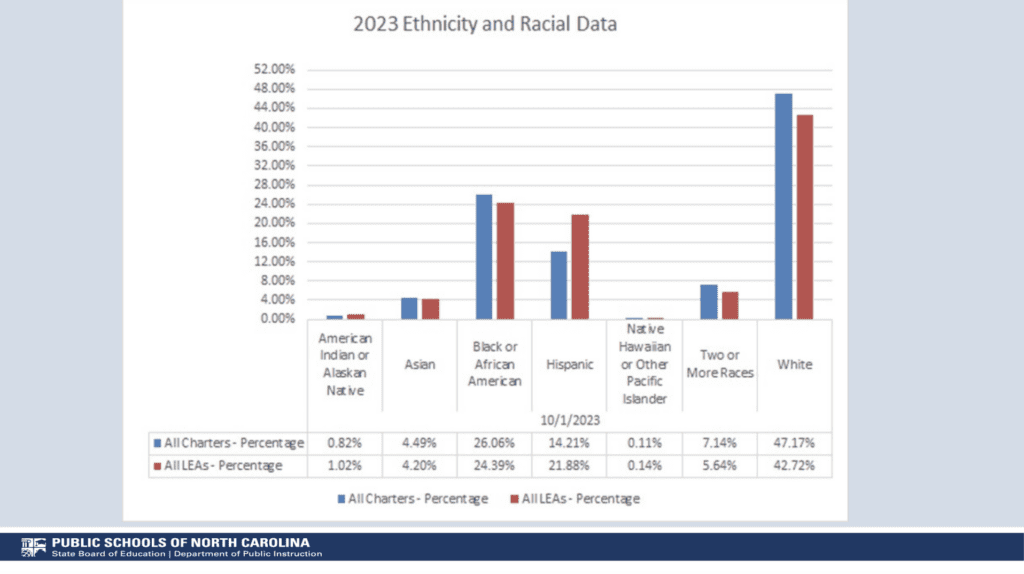
DPI data also show that traditional public schools consistently enroll a larger share of students with disabilities, English learners, and economically disadvantaged students. Traditional public schools enroll twice the amount of English learners that charter schools do.
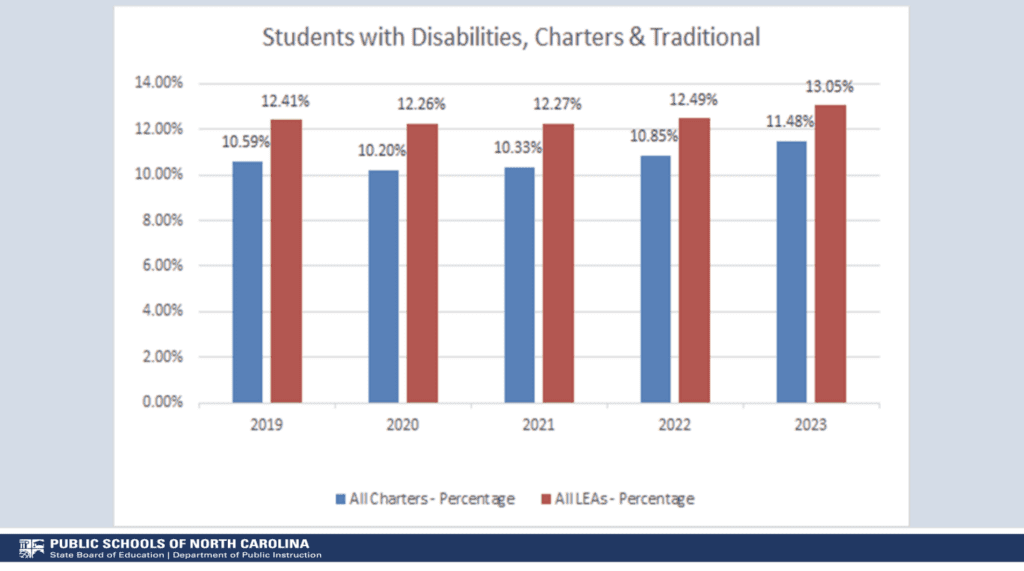
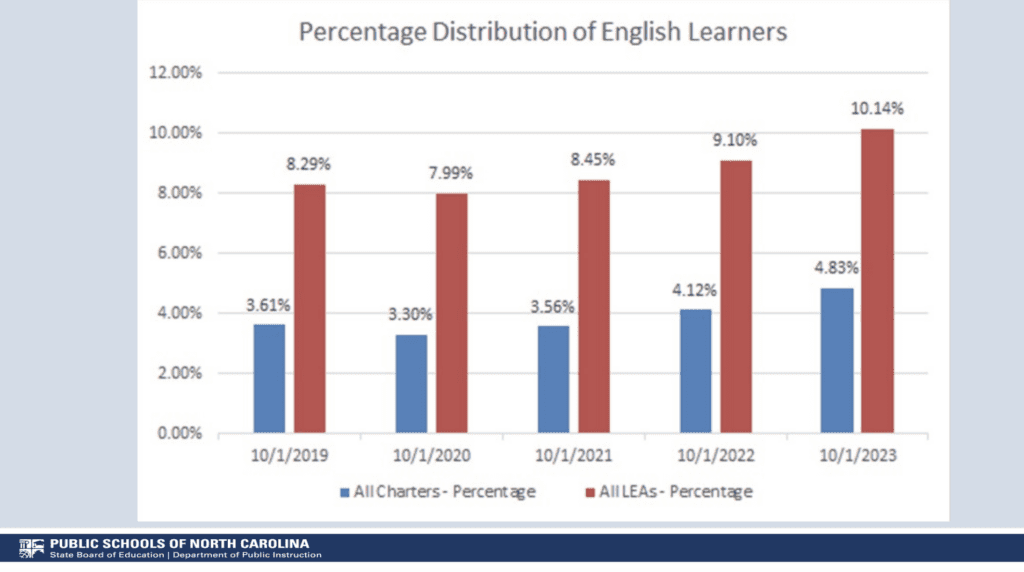
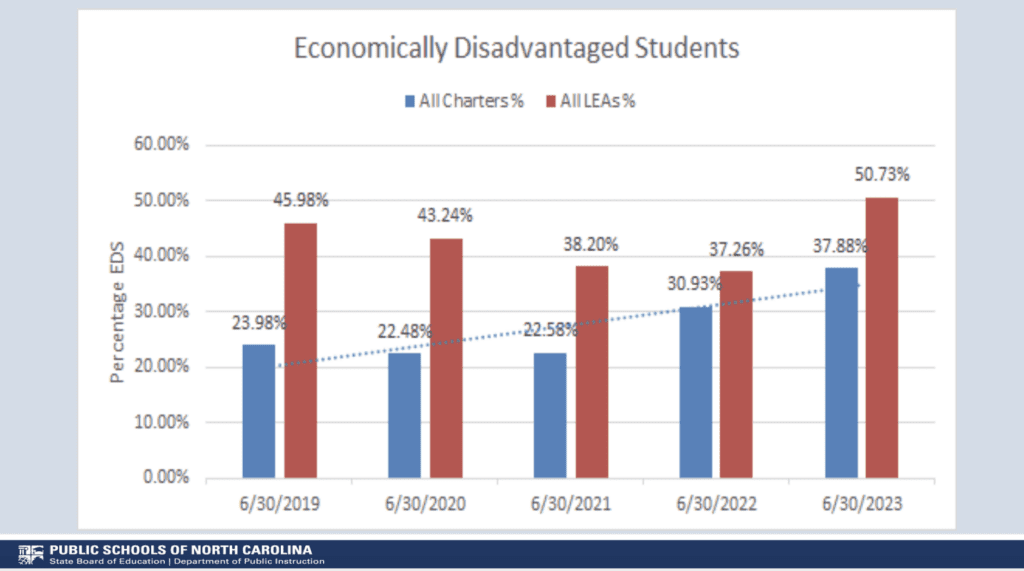
There has been an increase in the number of economically disadvantaged students at charters in the state, Baquero said, but there is still a gap. In 2023, 51% of all public school students were economically disadvantaged, compared to 38% of all charter schools.
Several factors play into this gap, including transportation, the National School Lunch Program, federal Medicaid direct certification, and charter reporting.
In North Carolina, state statute that charter schools are supposed to develop a plan to ensure “that transportation is not a barrier to any student.” However, unlike traditional public schools, charters are not required to offer formal transportation and busing services for students. Charters are also not required to provide free and reduced school lunches, though the number that do has risen in North Carolina in recent years.
“The state legislature should strengthen its charter school regulation by holding charter schools accountable for diverse student enrollment practices and require that charter schools offer transportation and free or reduced-price lunch to qualifying students,” the UCLA report says.
Baquero said more than 70 charter schools have been approved to offer weighted lotteries, “give additional weight to individual students who are identified as part of a specified set of students falling under the educationally disadvantaged definition.” This could include students who are economically disadvantaged, students with disabilities, migrant students, immigrant students, English learners, and homeless or unaccompanied youth.
As charter schools increase services to provide access, Baquero said schools must make sure parents and students know about such services.
“Charters are driven by demand and choice, so school leaders and boards must understand how everything from how you market and communicate to parents to communicating admissions procedures and school services are critical for parents to understand accessibility,” she said.
DPI data also show that charter schools and traditional public schools , based on school performance grades and school growth.
Here’s a look at comparison data of low-performing (LP) and continually low-performing (CLP) schools, at the charter and district level. You can see the percentage for both markers was similar in 2023 among charters and traditional public schools (27% LP & 25% CLP in charters, compared to 29% LP & 26% in traditional public schools).
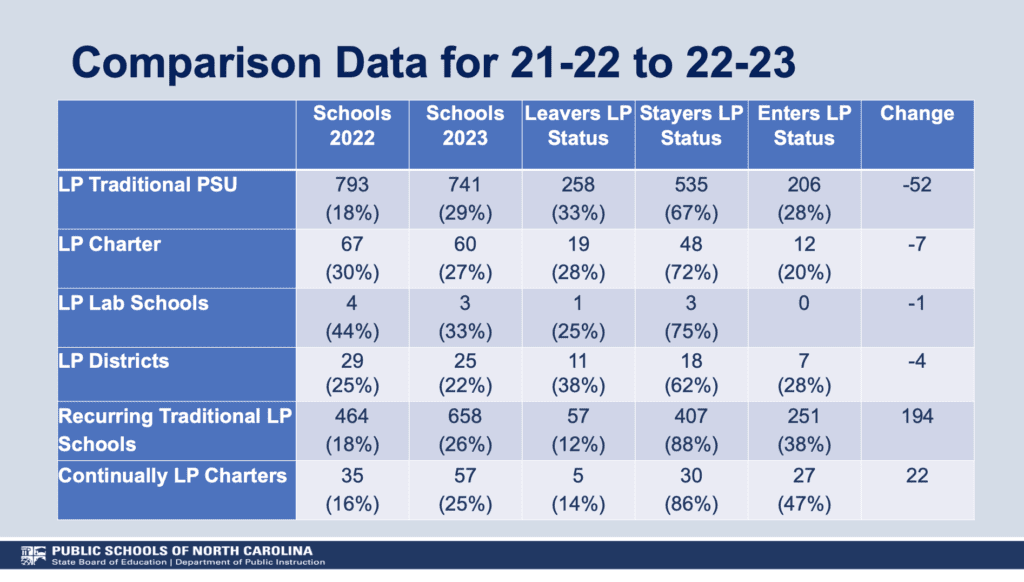
You can view DPI’s full 2023 report on charter schools .
This first appeared on and is republished here under a Creative Commons license.
Get stories like these delivered straight to your inbox. Sign up for The 74 Newsletter
;)